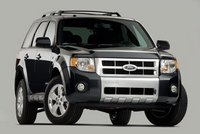Ford Escape 2008 Review
SEE ALSO: Compare Ford Specs and Prices - Ford Buyers Guide
One Week With 2008 Ford Escape XLT
By Thom Cannell
Senior Editor
Detroit Bureau
The Auto Channel
Authors Note: No attempt at completeness, simply comments on one week’s driving experience—balanced against decades of experience and hundreds of comparisons.
Ford’s 2008 Escape, while not drawn from a completely new sheet of metal, is significantly restyled inside and out, significantly improved, and all-around significantly better. In other words, it is a significant personal-sized SUV available in two-wheel drive and all-wheel drive models.
For 2008, Escape’s exterior now closely resembles Explorer and Expedition with a bolder grille, blacked-out B pillar, integrated running boards, higher beltline, and a raised “reverse crease” hood design that seems to imply European pedestrian impact protection compliance. The new front end moves headlamps higher and more outboard to the corners, which are flanked by side marker lamps.
While engines are unchanged from last year (other than small running improvements to the 4 cylinder Duratec 23 or Duratec 30 V6,) the largest change is enhanced quietness. Having owned a sibling Mazda Tribute, the difference in overall quietness and particular in high speed wind noise reduction makes Escape a much more pleasant long distance driver.
Interior NVH (Noise Vibration and Harshness) is said to be 12% quieter on the highway—up to 20% improved in cross winds. This is because of an “acoustic windshield,” on with sound suppressing plastic between panes of safety glass. Other changes that make the vehicle quieter are improved airflow over the roof, speed sensitive electric power assisted steering that reduces fuel use and eliminates hydraulic power assist noise, and both an acoustic headliner and up to 50% thicker carpeting. Chassis modifications were limited to NVH-related items like bushings, dampers and springs. Chassis design remains fundamentally the same at previous models.
What owners and passengers will notice more is the interior’s “Ty Pennington” complete makeover. Hard surfaces like the dash and windowsills have two surface treatments. One is shaped similar to snake scales, the other a faux-leatherette that makes no real attempt to look like leather, just a pleasant graining pattern. My test vehicle utilized a charcoal black color palette, but, depending on model, choices of camel, black and stone are available.
For the driver, a redesigned instrument panel features large clear and easy to read tachometer and speedometer plus temperature and fuel gauges, and the now-traditional Ford information center continues to furnish information on trip distance, fuel, and the critical distance to empty.
The new center stack is interesting. This Escape XLT had a large centered “eyebrow” display group atop the center stack that provided exterior temperature, interior driver and passenger temperature settings, a compass, an indication of the fan speed, plus date and time. Below this are ventilation and audio system controls, a standard 3.5 mm auxiliary audio input, controls for an optional in-dash navigation system, and available heated seats. Dials, buttons, and the audio system penetrated the console fascia for a clean and tight appearance. One luxury feature worth mention, HVAC controls—like high-end audio systems—are electronic, not mechanical. While completely automatic, control functions are as simple and explicit as a manual system. Escape is also first to use Ford’s new signature Ice Blue interior lighting.
Escape’s interior uses what Ford believes to be the first U.S. automotive application of seating surfaces made from 100% post-industrial waste—undyed polyester fibers and pop bottle production waste. This use of recycled fibers, opposed to virgin, could conserve an estimated 600,000 gallons of water, 1.8 million pounds of CO2 equivalents, and more than 7 million kilowatt hours of electricity annually, according to Ford. The new fabric seems to offer the same tactile qualities as previous fabrics, and Ford tested it for ingress/egress wear and tear, seam strength, color consistency, and the elusive “new car” aroma. Its use extends to the rear seats, which are comfortable and easy to fold up for increased cargo capacity. The rear cargo capacity is about two-thirds the volume of an Explorer (66.3 cubic feet behind first row, 29.2 cu. ft. behind second row vs. 85.8 / 45.1 for Explorer) and Escape has a similar lift over.
Here’s the Executive Summary:
Good Restyling enhances Escape’s appearance and should widen buyer interest. The same goes for interior restyling, it changes the cabin from “first apartment” into your first townhouse and the restyled dash and instrument panel add richness to a once utilitarian SUV. Emphasis on cabin quietness makes it a much more pleasant commuter or long distance traveler. Room for improvement Average 20.5 mpg hits EPA estimates and is similar to competitors, but needs a six-speed automatic. While much quieter, Escape needs continuing improvement on interior quietness and comfort to remain competitive. Despite all the improvements, it is time for a total redesign to compete with RAV4, CR-V, Jeep Patriot, and Compass.



